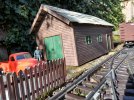After years of prep work on the tiered xerrascape garden I am finally getting some track and plants in and am looking ahead to structures. Several years ago I built a good sized freight depot and took time and planned and used what I thought were the proper materials to withstand the weather outside here. We live in the Rockies at about 8500 ft elevation 50 miles SW of Denver, summer temps as high as 90 and very low humidity, sun is intense here. Can have long dry periods and long heavy rains, can get considerable snow sometimes and temps down to about 15 below.
The structure I built used cedar 2x2 framing with Bin Primer and the core was Johns Manville "Go-board" which is a resin-urethane glass fiber product made as a tile backer board so it is impervious to water and weather. The core structure held up fine, it was the dinishing materials that could not hack the weather.......
Styrene shingle and clap board material shrunk, twisted warped and started to release itself even though I used several coats of construction grade contact cement to apply it. Trim boards fell off (Attached with Walthers goo). The freight dock kept coming apart. it was made of pine that was stained to provide a weather seal and assembled with Epoxy and still no luck.
Give the price of pre-made buildings, lack of availability and very limited selection, I am open again to scratchbuilding a few select buildings but I need some advice on how to finish structures, specifically the following......
1.....Roofing materials and attachment
2...Trim board materials and attachment
3.....Freight dock construction
4.....How to make durable stone wall structures
5....How to make durable clap board and board and batten type buildings
6.......I want to do some ADOBE structures......tips and advice please ?
Thank you for your consideration and assistance
The structure I built used cedar 2x2 framing with Bin Primer and the core was Johns Manville "Go-board" which is a resin-urethane glass fiber product made as a tile backer board so it is impervious to water and weather. The core structure held up fine, it was the dinishing materials that could not hack the weather.......
Styrene shingle and clap board material shrunk, twisted warped and started to release itself even though I used several coats of construction grade contact cement to apply it. Trim boards fell off (Attached with Walthers goo). The freight dock kept coming apart. it was made of pine that was stained to provide a weather seal and assembled with Epoxy and still no luck.
Give the price of pre-made buildings, lack of availability and very limited selection, I am open again to scratchbuilding a few select buildings but I need some advice on how to finish structures, specifically the following......
1.....Roofing materials and attachment
2...Trim board materials and attachment
3.....Freight dock construction
4.....How to make durable stone wall structures
5....How to make durable clap board and board and batten type buildings
6.......I want to do some ADOBE structures......tips and advice please ?
Thank you for your consideration and assistance






